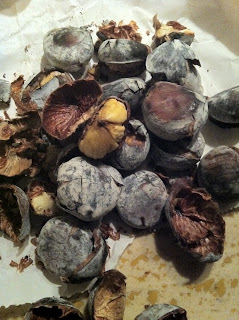The American chestnut was once an important source of hardwood in the United States and made up more than 25% of the trees on the east coast, prolific in the Appalachian Mountains from Georgia to Maine. Chestnuts featured prominently in American cooking from the colonial times. In the early 1900’s an Asian fungus brought from China caused a blight which wiped out most of the chestnut trees on the eastern seaboard, and in decades changed the makeup of the forests there. While they aren’t extinct, they rarely get big enough to produce nuts before the fungus finds them and wipes them out. Today the majority of chestnuts in our stores in the winter are from Italy, many of them from the hills around Montella in Campania, my grandma’s hometown, where it is a major local industry.
In big cities like New York, London and Rome, this time of year brings out the street vendors selling chestnuts roasted, and sometimes burned, over a small fire. I’ve always loved buying a little sack to warm my hands and munch as I walk around town looking at Christmas lights.
Street vendors in Trapani, on the island of Sicily, also roast them over a small fire, but they have a special twist that produce the best roasted chestnuts I've ever had. Close to Trapani are ancient salt flats, where they have been producing high quality sea salt for almost 3000 years. The street vendors there roast the chestnuts on top of tall stove-pipe chimneys, tossing salt on the burning coals, which surprisingly coats the skin of the chestnut and adds a lovely saltiness while you’re peeling and eating them.
To cook chestnuts you can either boil them or roast them, depending on what you’re going to do with them. To use them in soups, stuffings or braised dishes, just cover them with water and bring them to a boil, turning down the heat and simmering for about 20 minutes or until they’re cooked through. The chestnut has a shell as well as a brown paper-like peel on the meat inside and you must remove both of those before eating. Chestnuts peel best when they’re hot and if you’re having a hard time getting the brown peel off you need to put them back on the stove to get them hot again.
One of my favorite ways to finish a meal at the holidays is with roasted chestnuts. To roast chestnuts you have to make a cut in the shell, just one slit about an inch long will do, put them on a sheetpan in a 350 degree oven and cook them about 30 minutes. Make sure you cut through the skin because if you don’t the chestnut will explode in the oven, and believe me, that exploded chestnut meat goes everywhere and is hot! I had one explode in my face once and I don’t recommend it. Serve the chestnuts hot, along with some clementines or tangerines and a good bottle of red wine. It’s a lovely way to relax after the meal, just peeling the nuts, drinking some wine, giving you a chance to stay at the table just like the Italians do!
Following is a recipe for chestnut soup, one of my favorite winter dishes. If you can find canned chestnuts feel free to use them, just make sure they don’t have sugar added for use as dessert.
Whether boiled or roasted, chestnuts add a richness and meatiness to soups, stuffings and braised dishes and make holiday dishes seem extra special.
Buon Appetito and Happy Holidays! Gina
Zuppa di Castagne (Chestnut Soup)
6 oz pancetta, diced
1 small onion, chopped
1 leek, chopped
½ bulb fresh fennel, chopped
1 garlic clove, minced
2 tbsp extra virgin olive oil
3 tbsp butter
1 sprig rosemary, chopped
4 cups chestnuts, or two cups meat
water
salt
2 bay leaves
½ - 1 cup cream
Boil the fresh chestnuts in enough water to cover for 20 minutes. Peel the chestnuts, taking them from the pot of water one at a time. If they are at all difficult to peel, put them back in the water or reheat the water. Chestnuts peel easiest when very hot. If using dried chestnuts, place them in boiling water, turn the fire off and leave them to soak until softened.
Sauté the pancetta in a soup pot, remove to the side when lightly browned. Add the butter and olive oil to the pan and sauté the onion, leek, garlic and fennel until soft and translucent. Add the rosemary, then the pancetta and boiled chestnuts. Stir to coat with the oil, add enough water to the pan to cover, add the bay leaves, salt to taste and simmer for 30 minutes. Just before serving add the cream. Serve with croutons.


No comments:
Post a Comment